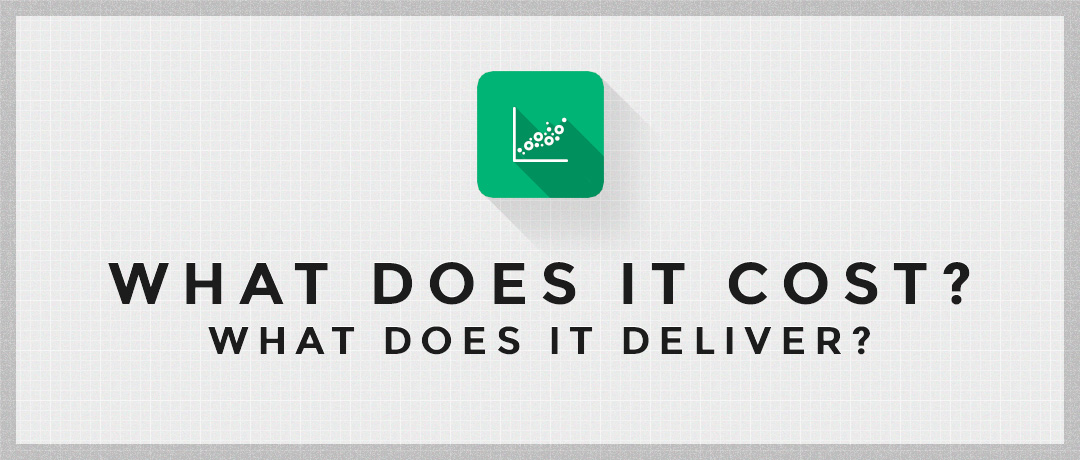Join 40,000+ sales and marketing pros who receive our weekly newsletter.
Get the most relevant, actionable digital sales and marketing insights you need to make smarter decisions faster... all in under five minutes.
ROI & UX: How to Calculate and Prove the Value of User Experience Design

Aug 18, 2015

Optimizing the user experience is a never ending goal for many companies, but it's also one that some tend to fall flat on or never even bother to look at.
For those who have recognized the value in UX, it can be a struggle to try and explain it and get those a little higher on the food chain to invest in it.
Traditionally, you see this type of push back from clients or even superiors who complain that there’s no budget, or that they need to think about the bottom line at the end of the day. How could you possibly calculate and justify the value of UX design to superiors without some hard statistics?
While it’s easy to point the finger at those who just aren’t understanding your point-of-view, the reality is that you need to meet eye-to-eye with them and develop reasonings that resonate with achieving their goals.
To help bridge the gap between the benefits of UX and its ROI, here are several key facts and statistics you can use to prove the advantages of investing in it along with some key elements to begin testing with.
UX and Its Huge ROI
It’s pretty clear that UX can’t be ignored on your website or within your software, otherwise potential users will surely flock to your competitors in hopes of a better experience.
Even big name companies are concerned about the benefits of optimizing for their users. IBM stated in their write-up on User-Centered Design that “every dollar invested in ease of use returns $10 to $100.”
Even though it’s a pretty powerful statistic, this quote begs the obvious question “where are those returns coming from?”
To help answer this, lets look into some of the ways UX helps decrease spending from many poorly planned and executed projects.
Reduces Wasted Development Time
I remember being told by many of my teachers and professors that if you want something done right the first time, do the proper research prior otherwise a majority of your time will be spent trying to fix pitfalls that could have been avoided in the first place.
By researching and utilizing best UX practices, you can stop wasted time and reduce development time as a whole by up to 50%.
And if you still believe the consequences of avoided research aren’t that high, you’re wrong. Trying to remedy an error after development is up to 100 times more expensive as it would of been prior.
This is why making the proper investments in the earlier stages of product planning can help your designers and developers better understand how the project should be structured and displayed to best suit users needs.
Decreased Customer Support
Your users shouldn’t have to be trained on using your software or website just because you know internally how it works, it’s not worth spending time and money into teaching them if it’s too complicated to begin with.
If you do have software that needs to have some instructions accompanied with it, then it’s best to at least create streamlined documentation that ultimately reduces the amount of time you need to put into training the end user.
Otherwise, if you product isn’t designed for them, you end up with an increased amount of calls to your support, causing you to hire more people to support the demand for help.
Increases Your Sales
Increased Customer Retention
People tend to flock back to products they find designed to their liking and are able to complete their desired tasks with ease.
Don’t believe me? Take a look at the battle between the Apple iPod and Microsoft Zune. While both were virtually the same product, Apple’s sleek and native interface (as well as the iPod’spartner in crime, iTunes) managed to resonate better with users then the Zune did.
And if you’re looking for numbers, 14.4% more customers are willing to purchase another product if your software doesn’t meet their expectations. But if you do manage to please your users, 16.6% of those who become customers are likely to recommend your product. (Forester)
By providing your users with a unique and memorable experience, you begin to build a relationship with them and will eventually nurture them into becoming brand advocates.
Increased Conversions
Now we’re talking, right?
One of the most easy and cost effective ways to double your revenue is to begin focusing on ways to double your conversions rather than doubling your traffic.
But many of us already try to increase conversions via A/B tests, yet we unfortunately tend to find ourselves at an impasse when we are just merely guessing what we think is going to work.
This is where early research can be used to understand how users behave on your website; how are they trying to complete certain tasks? Where are they hitting friction? What colors and styles are helping them complete their journey?
These questions especially come into light when asked how users perform when traveling down the websites sales funnel.
If you manage to optimize for the sales funnel, the ultimate result is an increase in sales allowing you to measure the value of how user experience contributes to additional profits.
Elements to Test
The best way to drive the importance of UX to your business stakeholders or client is to start talking numbers as these allow you to compare before-and-after results against your own internal products or your competitors’ performance.
While we have already touched base on where some of the numbers could come from, there are also some more in depth equations you can use to calculate where your loses/gains are coming from depending on how your UX is optimized.
The best overall way to calculate ROI for UX is to first decide your key indicator’s, estimate the lost opportunities you have due to poor UX, estimate the cost to fix it and/or the cost to do it right, then do the math.
An example of the equation might look something like this: (# of Error) x (Avg. Repair Time) x (Employee Cost) x (# of Employees) = Cost
Equations such as these can be used to calculate average order value or net value per visitor, support costs, and savings of users time.
For a more in depth look at creating equations for factors like these, try checking out this UXmatters article on discovering the proper metrics and how they should be calculated.
Download The Inbound Marketing ROI Report
Fill out the form below for over 30 pages of data

Free: Assessment